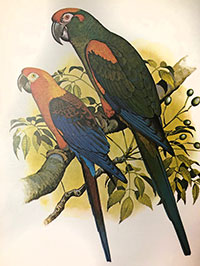Red-fronted Macaw: Straight Outta South Central (Bolivia)
 By Brian Kluepfel
By Brian Kluepfel
I began last week writing a doom-and-gloom blog about the red-fronted Macaw, which exists only in a small area of Bolivia’s Andean foothills and dry river valleys, between the cities of Cochabamba, Sucre and Santa Cruz.
Che Guevara breathed his last near here, and my fear was that the red-fronted macaw was in the same mortal danger. And unlike Che, it was not only up against guns, but pesticides, too.
The story is one of inevitable conflict borne of human settlement (or encroachment); people moved into this region and began farming. They cleared existing shrubbery and trees upon which the macaws depended. They planted corn and other crops, so instead of eating seeds of the soto (hardwood tree in the cashew family), pica pica, palo borracho (ceiba or silk floss tree) and culque, the macaws began to supplement their diet with corn and peanuts. Farmers, hence, began to view the macaw as a pest that reduced crop yields. Bang, bang.
Although community tourism has helped reverse anti-macaw sentiment in recent years, it’s still a battle to save this lithe, multicolored bird. (Of the 15 extant wild species of macaw, the red-fronted is the slimmest. Maybe the Bolivian macaw corn diet will be the next fad, after Paleo.)

Another continuing setback to the macaw’s survival is the illegal pet trade. A hundred bucks in the hands of a poor farmer can be irresistible.
The International Union for Conservation of Nature (IUCN) Red List, which is an often-depressing listing of species in decline, last reported on the red-fronted Macaw in 2018, and the stats were alarming. At most, according to IUCN, there were about 600 remaining in the wild; realistically, perhaps closer to 300. Yikes! That means a species listed officially as CR – critically endangered.
But folks doing the boots-on-the-ground research in Bolivia promised me a new survey soon, and numbers which aren’t nearly as depressing as the IUCN’s. In this day and age, one should consider multiple sources when making judgments, especially “the sky is falling” sort of proclamations involved in species extinction.
It may be that newer studies and more advanced science show a greater number of red-fronted macaws than we thought existed. Some sources, other than the IUCN, estimated between 1,000 and 2,000. Data can be used for different funding and political reasons, so it’s worthwhile to uncover accurate assessments, which are discovered through proper scientific diligence.
The red-fronted macaw is also part of the ongoing debate about bird names. Short summary: many in the birding community would like to get rid of Euro-centric honorific bird names (i.e., McCown’s Longspur, named for a Confederate soldier) altogether. Well, the red-fronted macaw has a completely logical name because its forehead, ear patches and upper legs are red.
The bird was first recorded by western science by a late 18th century or early 19th century French nobleman named Frédéric de Lafresnaye, and is sometimes, but rarely, called LaFresnaye’s macaw. I have no evidence that LaFresnaye was either a good or bad man, but I vote for the Quechua name (Quechua is an indigenous highland language and Bolivia’s official second tongue): Qa Qa (or Q’aca).
Loro, or “parrot of the rocks,” because it lives in cliff dwellings. And Qa Qa is a pretty cool name, isn’t it?
This lovely loro is a natural redistribution center. By cracking open cacti fruits and other seeds and eating them, it disperses them now – or later. Poop is the great equalizer in nature.
Having more cacti and native plants, which require little water, is less of a drain on these fragile river valleys. The birds can be an ambassador for the region, bringing in tourists (avid birders can see this bird in the wild only in this small corner of the world) and rebalancing the regional flora by moving the seeds around.
There are many lessons in the tale of the red-fronted macaw:
- Humans and birds can co-exist, if there is incentive on part of the humans (capitalism leading to eco-tourism).
- We should be careful what we call things and remember that the oldest names might be the wisest.
- Keeping birds in captivity – whether they are bred or illegally trafficked – is unnatural and it teaches the next generation that it’s okay to keep animals that are born to fly in cages.
- We should take care in forming judgments based on just one data set (or news channel), because there’s a lot of noise, and not all of its news.
Brian Kluepfel writes for the Lonely Planet travel guide series and is a proud member of Saw Mill River Audubon (SMRA). He encourages you to get involved in local birding with SMRA, and when you travel, to support community and eco-tourism whenever you can. Find him at www.birdmanwalking.com.

Examiner Media – Keeping you informed with professionally-reported local news, features, and sports coverage.

 By Brian Kluepfel
By Brian Kluepfel